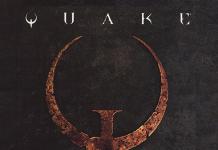The post is dedicated to the greatest games of our youth on personal computers
First-person shooter video game developed and published by id Software in 1993. Doom is one of the most significant and influential video games in the history of the industry; in particular, its popularity largely determined the further development and spread of the first-person shooter genre.
The series also saw the release of the sequel Doom II: Hell on Earth (in 1994), as well as the additions The Ultimate Doom (1995), Master Levels (1995, a collection of the best levels for the game created by enthusiasts and combined id Software) and Final Doom (1996). The game was developed for PC running DOS, then ported to various platforms, including ten game consoles. In 2004, the game Doom 3 was released, retelling the old story in a new way, based on which the feature film Doom was shot in 2005.
A first-person shooter computer game developed by id Software and released on July 22, 1996 (full version).
Before the official release of the full version of the game, namely on February 24, 1996, a technological demo version of the game called QTest was released. It did not support a single player mode of the game, and part of the gameplay was not yet finalized, however, thanks to the presence of multiplayer support in the game, dozens of servers for online games appeared in the world literally in a day. Then, on June 22, 1996, a shareware version of the game was released, including only the first episode, and available for download from the official id Software website.
The game made a breakthrough in 3D technology, using textured polygonal models instead of sprites, thereby realizing a fully 3D world, instead of a 2D map with height information (as was the case in Doom).
Most of the Quake engine was written by John Carmack. The game is also known for its soundtrack composed by Trent Reznor of Nine Inch Nails. Quake is the forerunner of one of the most successful gaming franchises ever, with over 4 million copies of Quake, Quake II and Quake III: Arena sold together. At the end of 2005, the continuation of the series was released - Quake 4, which is a plot continuation of Quake 2.
With the advent of the first Quake, the concept of “e-sports” was born, a vast community arose, major championships began to be held, and the concept of tricking in relation to computer games arose: the use of some game bugs in character movement to achieve superpowers by professional players, specially adjusted in professional mods

First-person shooter video game developed by 3D Realms (a division of Apogee) in 1996. Duke Nukem 3D is a logical continuation of the games in the Duke Nukem series, but if the first two games from the series were two-dimensional platformers, then the third part was made in the then popular Doom style (pseudo-three-dimensional corridors, first-person view, battles using various types of cold, firearms). , as well as fictional weapons). In fact, Duke Nukem 3D was Apogee's answer to the Doom series, as well as id Software's Heretic and Hexen.
But the new, three-dimensional part of Duke Nukem did not become another clone of Doom, it managed to compete with the more technically advanced Quake that was released at the same time. Moreover, it brought so many innovations and unexpected solutions to the gaming industry that it can rightfully challenge the title of the progenitor of many modern shooters, including the Half-Life series of games.
It was released on Steam on March 20, 2013 as a re-release of Duke Nukem 3D: Megaton Edition with three add-ons and early support for Steam Workshop and multiplayer through Steamworks.
In addition to a single passage, multiplayer is also possible, supported only by Windows 95 - later systems refuse to run it, and earlier ones do not recognize it, while the single version of the game runs on Windows XP


Computer game, a fantastic first-person shooter developed by the American company Raven Software in conjunction with id Software, Pi Studios, Endrant Studios and published by Activision. Wolfenstein is a sequel to the 2001 game Return to Castle Wolfenstein and uses the id Tech 4 game engine. The game was released for PC, Xbox 360 and PlayStation 3 platforms. The game was released on August 18, 2009 in North America, August 19 in Australia and August 21 in Europe. The game appeared in the digital distribution service Steam on October 13, 2009.

First-person shooter video game developed by Monolith Productions and published by GT Interactive in 1997. The game uses the Build Engine (previously used in Duke Nukem 3D), and is the first Build Engine game to use voxels. Blood contains a large amount of occult symbolism, violence and dark humor. The game is also characterized by unusual weapons for a 3D shooter. Later, two add-ons were released for the game: "Plasma Pack" and "Cryptic Passage".

Video game in the genre of arcade survival race. The creators of the game were inspired by the 1975 cult classic Death Race 2000, and they just wanted variety in racing. The name of the game is made up of two English words: Car (car) and Armageddon (Armageddon).
The music for the game was taken from the Fear Factory album Demanufacture.


resident evil
Media franchise owned by Capcom and created by Shinji Mikami, influenced by George Romero's The Living Dead film series, as a series of survival horror games. The first in it was Resident Evil, released in 1996 on the PlayStation and subsequently ported to the Sega Saturn and PC. The games in the series have since sold 46 million copies as of December 31, 2011.


Action/RPG computer game developed by Condor (later renamed Blizzard North), which was purchased by Blizzard Entertainment along with the game prior to publication, and published on December 31, 1996.
The game is made in the style of dark fantasy. The player is invited to go alone to the dungeons of the city of Tristram, flooded with various demons, undead and other evil creatures. Moving deeper and deeper through the levels of the dungeon (there are 16 in total), the player eventually ends up in Hell, where they must find and kill Diablo, the main boss of the game.
Also, Sierra Entertainment released an add-on game called Diablo: Hellfire.

A real-time strategy video game developed and published by Blizzard Entertainment in 1998. On November 30 of the same year, an add-on was released - StarCraft: Brood War, which added new playable units to the game and continued the plot of the original. In 2010, the first part of the sequel trilogy StarCraft II: Wings of Liberty was released, in 2013 the second part, StarCraft II: Heart of the Swarm, was released. In Russia, the game was published by Soft Club, but was not localized.


A role-playing game set in a world that has survived a nuclear war. The game, released in 1997 by Interplay Entertainment, was developed by its Black Isle Studios division. One of the most famous works of the post-apocalyptic genre. At the development stage, it was assumed that Fallout would become a de facto sequel to Wasteland, but due to Interplay's lack of rights to Wasteland at that time, Fallout did not become its official sequel. The game developed its own role-playing system called SPECIAL and replaced the GURPS system, which was originally planned to be used.
The plot of the game follows the adventures of the Vault Dweller, a resident of an underground bunker who has been tasked with finding a water chip within 150 days and delivering it to his hideout in order to save an isolated community from water shortages. The player can freely move around the world map, visit game locations, complete various tasks and fight with representatives of the surrounding world.
Acclaimed by critics, the game marked the beginning of the Fallout series. Among the advantages of the game, reviewers highlighted the innovative setting, the openness of the game world and the realism of the gameplay. For several years, Fallout has featured on various gaming publications' lists of the best games.
The game was officially localized and published in Russia on February 15, 2008 by 1C; in 1998, unlicensed versions of the game were released on the Russian market, translated by Fargus and 7 Wolf studios (the exact release date is unknown).

Legendary games of the 1980s and 1990s
© 
Games on computers and consoles appeared a long time ago, and every year they only get better. Nevertheless, their classic designs managed to bring up several generations and still cause bouts of nostalgia. Lenta.ru journalists Mikhail Karpov and Artem Kosmarsky tried to compile the top games that had made the greatest impression on them in their time.

The Big Red Adventure- A 1995 quest about the adventures of an American geek in perestroika Russia. The choice of this game is due to the desire to somehow represent the domestic contribution to the gaming culture of the 1990s. Everything is as it should be, with a good level and graphics: MakVodka and Lenintendo, pitching and a conspiracy of generals for the revival of the USSR, as a result of which the resurrected Lenin is arranged as the host of the Matryoshka Show.

"Civilization" - and that says it all. Start with a group of nomads, establish the first city, learn how to make bricks, gunpowder, defeat competitors, and then reach a nuclear bomb and an interplanetary spaceship. And all this in a few hours. I learned English from this game - I remember how long I was looking for the word masonry in the dictionary.

golden axes- An insanely beautiful game that was originally released for the corresponding slot machine, and then received versions for consoles and PC. Golden Ax is a 2D slasher game set in a world similar to that of Conan the Barbarian. You can play as an Amazon, a barbarian or a dwarf, and you can also use riding dragons to destroy enemies. The goal is to reach the main villain, the Deathbringer, and do the same with him as with other opponents - kill him (although this is very difficult).

Leisure Suit Larry- one of the most popular series of quests studio Sierra Games. There are no mysterious cities, magic, the main character does not explore unknown planets. The task of Larry, a balding middle-aged man, is simple - to find a girl who, in the language of Beavis and Butt-head, "gave". Since Larry is a chronic loser, many failures await him on the way to success.

Duck Tales- The Duck Tales game - all the kids and teenagers of the 1990s watched them. The goal is simple: collect as many treasures as possible within a certain time. They had to fly behind them on a plane controlled by a clumsy pilot Zigzag Makkryak (and the flight often ended in failure) to different parts of the globe. Treasures lurked in dark caves, in rocky mountains and in the jungle. And Ponochka earned capital by photographing rare animals.

Warcraft II- It was very similar to Dune II - the same real-time strategy, only in a fantasy setting. The first part, although it was necessary to build bases and produce units, was more focused on performing all sorts of extraordinary plot tasks for the strategy. And, of course, it was distinguished by an atmosphere that could not be repeated in the second.

Wolfenstein 3D- A peudo-three-dimensional game by iD Software, the forerunner of the famous Doom. The American marine William Blazhkovich must, having escaped from the dungeons of the prison in Wolfenstein Castle, wet the hordes of Nazis, collect stolen treasures and, finally, reach Hitler himself. Mountains of pixelated corpses and a bunch of sequels - successful and not very successful.

The Settlers- German strategy 1994. The main task of the player is to organize his own subsistence economy of the medieval type. Lumberjacks cut wood, foresters plant it; to get bread, you need to sow the field, collect the ears, take them (preferably on donkeys) to the mill, and then - the flour to the bakery. Miners must extract iron and gold, and blacksmiths must smelt them to make weapons. The crown of the whole economy is knights who capture other people's castles - but, unlike Warcraft, war plays a completely marginal role, and all the time the player is busy organizing roads, eliminating traffic jams, distributing resources and workers of various professions.

Lands of Lore- If we talk about role-playing games of the early 1990s, then Lands of Lore is a real benchmark here. This is probably even the first notable RPG in which there were such vivid characters and plot. You could empathize with them, and the cities, swamps, forests and dungeons looked so picturesque for the games of that time that you could admire them, forgetting about the passage. Unfortunately, everything was spoiled to the point of disgrace by a banal ending, after which the question arose: “And why did all this happen?”

dune- If the Dune II strategy is known to many, then not everyone knows the first Dune. Unlike the sequel, there is no need to build bases and produce countless units. Flying from sietch to sietch of the Fremen (the so-called settlements of the indigenous inhabitants of the planet Arrakis, on which the game takes place), you need to persuade them to cooperate, and then use them to extract spice and fight the enemy - the Harkonnen house.

Alien Legacy- One of the many space strategies of the 1990s. The plot is close to other classic examples of the genre, like Star Control II or Reunion. After a lost war with an alien race, a single ship of earthlings finds itself in an alien star system that needs to be correctly colonized (an element of strategy), and then find out, already on a galaxy scale, what happened to the Earth.

Panzer General- Turn-based strategy 1994, dedicated to the Second World War. The game is played as the Wehrmacht (the other side is represented in one of the sequels, Allied General) - you need to go through all the main campaigns of the European and African theater of operations, plus a few fictional ones (landing in England and America). In terms of complexity, as well as the accuracy of reproducing the military-historical reality (the parameters of individual types of weapons and the balance of power), the game has not become outdated at all. Separately, it is worth mentioning the design: buttons and panels in brass and mahogany, in the aesthetics of the Soviet "red rooms" at military units.

Pirates! Gold- An improved (in terms of graphics and music) version of the classic game by Sid Meier (the future creator of "Civilization") about the life of Caribbean pirates. This is an "open world" game unique for its time in terms of complexity: you can rob ships and cities, look for treasures, a wife and missing relatives, or simply trade in the expanses of the Caribbean. The game has elements of tactical strategy (land battles), a naval battle simulator and a quest. It is necessary to deal with rebellious moods in the team, monitor the economy of cities (so as not to spend precious resources on capturing a poor settlement) and the diplomatic actions of the country you serve, and your own age: after some time you are supposed to retire. According to the sum of successes in the game, the results are evaluated: you can end your life as a beggar, or you can end up as a royal adviser.

Pac man- this is a real classic, not knowing which is simply a shame. Gingerbread Man Pacman travels through the labyrinths, collecting glowing dots and bonuses. Four ghosts are chasing him. Collected all the points and bonuses, ran away from the ghosts - go to the next level. There are 256 levels in the game in total, although it was planned that it would be endless (after level 255, the player had to get to the first one again). Due to a programmer's mistake, it was impossible to pass the 256th level.

zero tolerance- The game is one of very few (only 5 games) representatives of the genre for Mega Drive/Genesis. A small window is used to display the game situation, and the rest of the screen is reserved for game statistics. The height of the floor and ceiling does not change. (Except in the case of stairs - the angle of elevation is 45 degrees - they are used as an analogue of elevators to move between floors). However, walls can be at 45 degree angles to each other, not limited to perpendicular intersections. The game has animated textures and the effect of blood splashes flowing down the walls.
The game was a commercial success. Subsequently, the game and its unfinished sequel, Beyond Zero Tolerance, were published by the developer company for free However, the company Sega, which owns the rights to some parts of the game code, did not give official permission for the free distribution of the game. It is also one of the very first first-person games.

doom is a first-person shooter video game developed and published by id Software in 1993. Doom is one of the most significant and influential video games in the history of the industry; in particular, its popularity largely determined the further development and spread of the first-person shooter genre. The series also saw the release of the sequel Doom II: Hell on Earth (in 1994), as well as the additions The Ultimate Doom (1995), Master Levels (1995, a collection of the best levels for the game created by enthusiasts and combined id Software) and Final Doom (1996). The game was developed for PC running DOS, then ported to various platforms, including ten game consoles. In 2004, the game Doom 3 was released, retelling the old story in a new way, based on which the feature film Doom was shot in 2005. In 2016, a new version of the game was released, which, like the first part, was called "DOOM", where the game was transformed into a modern shooter.

BloodShot (Battle Frenzy) is a first-person shooter game developed by Domark and published by Acclaim Entertainment in 1994 exclusively for the Sega Mega Drive/Genesis game console. She is one of the few representatives of this genre for the Sega console.
In its graphical performance, Blood Shot was somewhat inferior to its more successful counterpart Zero Tolerance, released for Sega in the same year. However, despite this, it had a number of characteristic advantages. The main advantage of the game was the more accessible multiplayer mode. Two set-top boxes, two cartridges, two TV sets and a special connecting cable were required to play Zero Tolerance together. Blood Shot, on the other hand, had a high-quality split-screen mode, and allowed two players to play on the same TV, both in cooperative and deathmatch modes.
The essence of the gameplay is similar to Doom. Players move through the maze collecting weapons, power-ups, and keys. At the same time, they destroy various enemies and bosses. There are also several types of keys, each of which fits a certain type of door. There are also secret rooms that can be discovered by chance. There are also traditional barrels here, the explosion of which causes damage to players or monsters nearby. The main distinguishing feature of the game is the need for a limited time to return to the starting point after the destruction of each boss. At the same time, the light on the level turns off, and the player has to get almost by touch.
The game consists of twelve main levels and three additional, for fighting against each other. The design is quite simple and monotonous. The game also has a system of "bonuses" - a set of weapons and useful items. If a player destroys three opponents without taking any damage, he is given a bonus. Bonuses are issued in a certain sequence: oxygen tank, Cannon, yellow key, Spray, Lock-On, red key, Piercer, etc.

The Chaos Engine (Soldiers Of Fortune) is the name of a game for the European market developed by the British company The Bitmap Brothers and published by Renegade Software in 1993. The North American version was released under the title Soldiers of Fortune. The game has a sequel called The Chaos Engine 2, released in 1996. It was first released for the Commodore Amiga, with a version available for the AGA Amigas, and later ported to MS-DOS, Super Nintendo Entertainment System, Atari ST, Amiga CD32, RISC OS, and Sega Mega Drive platforms. In the SNES and Sega versions, the Preacher character was removed and renamed the Scientist. The US versions of these two ports, the game was renamed Soldiers of Fortune. In 2014 on PC a remake of this game was released, which received mixed reviews on Steam.
Also below, you can watch my complete walkthrough of the game "Chaos Engine". I provide you with a video.

Bucky O Hare is a platform video game developed and published by Konami for the NES video game console in 1992. The game is based on the animated series Bucky O'Hare and the War on Toads.
According to the plot of the game, Bucky must save all the members of his team (with the exception of Bruther), moving from one planet to another. Immediately after the entire team is restored, all of its members except for Blinky are kidnapped again, and the player must again collect all the members of the team. After saving another member of the team, the player gets the opportunity at any time to switch between the rescued characters with different abilities.

A funny fact is that a pirated version of the game was in circulation in Russia, in which the developers' protection was not removed, which, when the game was turned on, scanned the title screen, and if it did not find the manufacturer's copyrights there, it included a hidden mode, which led to the fact that the main character died with one blow. Remarkably, this mode is also available in the licensed version. To start the game in this option, you need to enter the password "HARD!"

SimCity (1989)- a video game that marked the beginning of the city-building simulator as a full-fledged genre in the gaming industry. The game was developed by Will Wright and released for a number of platforms, primarily between 1989-1991. SimCity is made in two-dimensional graphics, the city is viewed from above. The essence of the gameplay comes down to the creation of a city, the development of residential and industrial zones, the construction of infrastructure and the collection of taxes for the further development of the city. In the game, as well as in the real world, it is important to raise the standard of living of the population and maintain a balance between different sectors, otherwise the settlement may fall into decay and even go bankrupt.
Despite the fact that the game was released in 1989, the simulator was independently developed by Will Wright in 1985, when he was just starting his career as an indie developer, that is, before the formation of the Maxis studio. However, for four years, game publishers refused to release the project for fear of a sales failure, as the game lacked any of the arcade or action elements that dominated the computer game market in the 1980s.
Brøderbund eventually agreed to distribute the game. Although SimCity did not sell well at first, sales of the simulator skyrocketed after positive reviews from the gaming press. A bestseller, the simulator was released on many other platforms, the most popular of which was the SNES version released in 1991, which, with the complicity of Nintendo, greatly improved the gameplay.
The city-builder was recognized as a new phenomenon in the gaming industry, and according to the press, it broke the belief among many personal computer users that computer games were primarily for children.
SimCity has received 24 awards from various news publishers and associations. Critics have generally responded positively to SimCity, calling its gameplay groundbreaking for the 1980s and the game itself very addictive, even though it lacks shooter and platforming elements. Also, according to reviewers, the game is very instructive and will help the player understand the basics of urbanism, politics and economics.

super mario is a video game released in 1985 by Nintendo. Listed in the Guinness Book of Records as the best-selling game in history. After the decline in sales of Mario Bros., released in 1983, the advent of Super Mario Bros. allowed them to quickly return to their previous level.
The protagonist of the game, Mario, became the symbol of Nintendo and one of the most famous fictional characters in the world, and the game itself was recognized by IGN in 2005 as "the best game of all time."

Might and Magic- - a series of computer role-playing games created by John Van Kanegem and his developer company New World Computing, which released the first game in this series Might and Magic Book One: The Secret of the Inner Sanctum in 1986. In 1996, New World Computing was acquired by The 3DO Company, which has been the publisher of the Might and Magic games ever since.
The early games in the Might and Magic series stood out from many other fantasy games in that they had elements of science fiction. The series achieved great popularity thanks to its spin-off - a series of turn-based strategy games Heroes of Might and Magic. The main Might and Magic series is also the name of a fictional universe in which the Heroes of Might and Magic series and other spin-off games also take place.
In 2003, 3DO filed for bankruptcy and the French company Ubisoft bought the rights to the Might and Magic series. Beginning in 2006, Ubisoft continued to release games under the Might and Magic brand, beginning with Heroes of Might and Magic V and Dark Messiah of Might and Magic. After the acquisition of the brand by Ubisoft, Erwan Le Breton became its new creative director. The action of the plot of the new games in the series was transferred to another fictional universe - the fantasy world of Ashan, which does not have elements of science fiction and is not connected with the plot of the previous games in the series.

Command & Conquer is a series of successful real-time strategy video games developed by Westwood Studios. The forerunner of the series is the game Dune II, which contributed to the development of ideas when creating the series (collecting resources, building a base without the participation of special units).
From 1984 to 2003, the game was developed by Westwood Studios, which was taken over by Electronic Arts Corporation in 1998. In 2003, EA liquidated Westwood, incorporating it into the EA Los Angeles subsidiary, which subsequently developed games under the Command & Conquer brand. Only Lewis Castle, co-founder of Westwood Studios, remained at EA. Most of the employees of the former Westwood Studios, not wanting to move to Los Angeles, remained in Las Vegas and, after leaving EA, founded their own studio, Petroglyph Games. [source not specified 528 days]. In February 2011, Electronic Arts created a new team, Victory Games, to which they fully transferred the development of further games in the series.
42 10
Genre: Action, Arcade, Strategy, Simulator, ...
Release year: 2013
Developer: Various
Publisher: Various
Edition type: Repack
Language (interface): Russian
tablet: not required
Description:
Author's repack, which includes a selection of 220 of the best games of the past years, from the early 80s to the late 90s.
The repack integrates the torrent-games.info DOS-emulator DOSBox 0.74 and a self-written launcher that launches the selected game with the optimal virtual machine configuration for it. Launching any game comes down to selecting it in the launcher and pressing the play button. All the work on setting up each game has already been done for you by the author of the repack :)
In general, if you caught the collapse of the USSR, if you are familiar with the "dashing 90s" by hearsay, if you remember 5.25" floppy disks, Poisk and Pravets computers, remember the phrase "Yes, Intel 386DX is cool!", If You are familiar with the phrases "Arkanoid", "Digger", "Super Mario", "Star Control", "Lode Runner", "Wolfenstein 3D", "DOOM 2", "Duke Nukem 3D", "Dune 2", "Warcraft I ", etc., and many of them cause an uncontrollable attack of nostalgia - You should definitely download this release!
System requirements
OS: Windows XP / 7
Sound: DirectX compatible
Video card: Any, DirectX compatible
Free disk space: 4.5 GB
Installation instructions
- Run setup.exe
- Install.
- Launch launcher
- Select a game
- Press the "Play" button
Repack Features
Based on distributions of old games from various sources
- all games are ready to go and configured for DOSBox sound hardware
Repack by dj_maxx
Games included in the collection
Abrams: Battle Tank
Airborne Ranger
Aladdin
ALBION
Alien Carnage
Alley Cat
Alone In The Dark
Alone In The Dark 2
Alone In The Dark 3
another world
Arcade Volleyball
Arkanoid
Arkanoid: Revenge of DOH
Back To The Future 2
Back To The Future 3
bad blood
Bad Street Brawler
barbarian
Barbarian 2
Battle Zone
Beneath A Steel Sky
Bioforge
Black Thorne
Blake Stone: Aliens of Gold
blockout
Blood: Spill Some
Bubble Bobble
Budokan The Martial Spirit
Caesar
Caesar II
Cannon Fodder
Captain Blood
Carmageddon
Catacomb 3D
cd-man
Chasm: The Rift
Chopper Duel
color lines
Comanche: Maximum Overkill
Command & Conquer
Command & Conquer: Red Alert
Commersant (Kommersant)
cool spot
Corporation
crime wave
Cruer: No Regret
Cruer: No Remorse
Dangerous Dave
Dangerous Dave: Dave Goes Nutz
Dangerous Dave: Haunted Mansion
Dangerous Dave
darklands
Death Rally
Death track
Descent
Descent 2
Desert Strike
Digger
disc world
Disney's Lion King
DOOM
DOOM II: Hell On Earth
Duke Nukem 3D
Duke Nukem: Episode One: "Shrapnel City"
Duke Nukem: Episode Two: "Mission: Moonbase"
dune
Dune II: The Building Of The Dynasty
Dungeon Keeper
Dyna Blaster (Bomberman)
Earthworm Jim
Earthworm Jim 2
eden blues
Elite
Elite Plus
Epic Pinball
Eye of the Beholder II: The Legend of Darkmoon
F-117 Nighthawk Stealth
F-15 Strike Eagle
F-19 Stealth Fighter
F-29 Retaliator
fade to black
Fallout
Fatal Racing
FIFA Soccer 96
Flashback: The Quest for Identity
Flintstones: Lost in Bedrock
Formula 1 Grand Prix
Frogger
Full Throttle
Gabriel Knight: Sins Of The Fathers
Gobliins
gods
golden axes
Goody
Grand Theft Auto
Heretic: Shadow Of Serpent Riders
Heroes Of Might And Magic
Hexen: Beyond Heretic
home Alone
Hovertank 3D
Indiana Jones
Jagged Alliance
James Bond: License To Kill
Jazz Jackrabbit
Judge Dredd
Jungle Book
Jungle Strike
Kicks
King's Bounty
Knightmare (Myth)
Lakers vs Celtics NBA Playoffs
Legend Of Kyrandia
Leisure Suit Larry 1
Leisure Suit Larry 2
Leisure Suit Larry 3
Leisure Suit Larry 5
Leisure Suit Larry 6
Lemmings
Lemmings 2
Lemmings 3
Liero
Livingstone Supongo
Lode Runner
Lost Vikings
Lotus: The Ultimate Challenge
Mac 3
Magic Carpet 2: The Netherworlds
Master Of Orion
MDK (Murder, Death, Kill)
MechWarrior
MechWarrior 2: 31st Century Combat
Metal Mutant
Metaltech: Earthsiege
Montazums Revenge
Mortal Kombat
Mortal Kombat 2
Mortal Kombat 3
One Must Fall
Operation: Wolf
Overkill
pacman
Panzer General
paratrooper
planet of zoom
Police Quest
Police Quest 2
Police Quest 3
Popcorn
Prehistoric
Prehistoric 2
Prince Of Persia
Prince Of Persia 2
Quake
Quarantine
Raptor: Call Of Shadows
Rebel Moon
Redneck Rampage
Rick Dangerous
Rick Dangerous 2
Rise Of The Triad
Robocop
Saboteur 2 (Durell)
Scorched Earth
Settlers
Settlers II
Shadow Warrior
Shamus
Shell Shock
Shinobi
Sid Meiers Civilization
Sid Meiers Colonization
Sim City
Sim City 2000
Soccer Italy 90
sopwith
Space Quest 1: Sarien Encounter
Space Quest 2: Vohaul Revenge
Space Quest 3: Pirates of Pestulon
Space Quest 4: Time Rippers
Space Quest 5: New Mutation
Space Quest 6: Spinal Frontier
star control
Star Control 2
Star Control 3
Star Fighter 3000
Star Goose!
Star Wars: Dark Forces
Stellar 7
street fighter
Street Fighter 2
Strife
supaplex
super mario bros
System Shock
Teenage Mutant Ninja Turtles 3
Terra Nova: Strike Force Centauri
test drive
Test Drive 3
The Incredible Machine
The Incredible Machine 2
The Need for Speed
Titus The Fox: To Marrakesh & Back
tomb raider
UFO: Enemy Unknown
Virtual Pool
Wacky Wheels
Warcraft II: Beyond the Dark Portal
Warcraft II: Tides of Darkness
Warcraft: Orcs and Humans
Wolfenstein 3D
Wolfenstein 3D: Spear of Destiny
Worms
Xenon
Xenon 2: Megablast
Xonix
Zaxxon
Zed
Zeliard
Kremlin Dungeons
Field of Dreams


Computer games have been around for a long time, and every year they only get better. Nevertheless, their classic designs managed to bring up several generations and still cause bouts of nostalgia. Journalists Mikhail Karpov and Artem Kosmarsky tried to compile the top games that had made the greatest impression on them in their time.

A 1995 quest about the adventures of an American geek in perestroika Russia. The choice of this game is due to the desire to somehow represent the domestic contribution to the gaming culture of the 1990s. Everything is as it should be, with a good level and graphics: MakVodka and Lenintendo, pitching and a conspiracy of generals for the revival of the USSR, as a result of which the resurrected Lenin is arranged as the host of the Matryoshka Show.

"Civilization" - and that says it all. Start with a group of nomads, establish the first city, learn how to make bricks, gunpowder, defeat competitors, and then reach a nuclear bomb and an interplanetary spaceship. And all this in a few hours. I learned English from this game - I remember how long I was looking for the word masonry in the dictionary.

An insanely beautiful game that was originally released for the corresponding slot machine, and then received versions for consoles and PC. Golden Ax is a 2D slasher game set in a world similar to that of Conan the Barbarian. You can play as an Amazon, a barbarian or a dwarf, and you can also use riding dragons to destroy enemies. The goal is to reach the main villain, the Deathbringer, and do the same with him as with other opponents - kill him (although this is very difficult).

DuckTales game - all the kids and teens in the 1990s watched them. The goal is simple: collect as many treasures as possible within a certain time. They had to fly behind them on a plane controlled by a clumsy pilot Zigzag Makkryak (and the flight often ended in failure) to different parts of the globe. Treasures lurked in dark caves, in rocky mountains and in the jungle. And Ponochka earned capital by photographing rare animals.

Warcraft II was very similar to Dune II - the same real-time strategy, only in a fantasy setting. The first part, although it was necessary to build bases and produce units, was more focused on performing all sorts of extraordinary plot tasks for the strategy. And, of course, it was distinguished by an atmosphere that could not be repeated in the second.

The first pseudo-3D game by iD Software, the forerunner of the famous Doom. The American marine William Blazhkovich must, having escaped from the dungeons of the prison in Wolfenstein Castle, wet the hordes of Nazis, collect stolen treasures and, finally, reach Hitler himself. Mountains of pixelated corpses and a bunch of sequels - successful and not very successful.

German strategy 1994. The main task of the player is to organize their own subsistence economy of the medieval type. Lumberjacks cut wood, foresters plant it; to get bread, you need to sow the field, collect the ears, take them to the mill, and then - the flour to the bakery. Miners must extract iron and gold, and blacksmiths must smelt them to make weapons. The crown of the whole economy is the knights who capture other people's castles - but, unlike Warcraft, war plays a completely marginal role, and all the time the player is busy organizing roads, eliminating traffic jams, distributing resources and workers of various professions.

If we talk about role-playing games of the early 1990s, then Lands of Lore is a real benchmark here. This is probably even the first notable RPG in which there were such vivid characters and plot. You could empathize with them, and the cities, swamps, forests and dungeons looked so picturesque for the games of that time that you could admire them, forgetting about the passage. Unfortunately, everything was spoiled to the point of disgrace by a banal ending, after which the question arose: “And why did all this happen?”
dune

If the Dune II strategy is known to many, then not everyone knows the first Dune. Unlike the sequel, there is no need to build bases and produce countless units. Flying from sietch to sietch of the Fremen (the so-called settlements of the indigenous inhabitants of the planet Arrakis, on which the game takes place), you need to persuade them to cooperate, and then use them to extract spice and fight the enemy - the Harkonnen house.

One of the many space strategy games of the 1990s. The plot is close to other classic examples of the genre, like Star Control II or Reunion. After a lost war with an alien race, a single ship of earthlings finds itself in an alien star system that needs to be correctly colonized (an element of strategy), and then find out, already on a galaxy scale, what happened to the Earth.

Turn-based strategy 1994, dedicated to the Second World War. The game is played as the Wehrmacht (the other side is represented in one of the sequels, Allied General) - you need to go through all the main campaigns of the European and African theater of operations, plus a few fictional ones (landing in England and America). In terms of complexity, as well as the accuracy of reproducing the military-historical reality (the parameters of individual types of weapons and the balance of power), the game has not become outdated at all. Separately, it is worth mentioning the design: buttons and panels in brass and mahogany, in the aesthetics of the Soviet "red rooms" at military units.

An improved (in terms of graphics and music) version of the classic game by Sid Meier (the future creator of Civilization) about the life of Caribbean pirates. This is an "open world" game unique for its time in terms of complexity: you can rob ships and cities, look for treasures, a wife and missing relatives, or simply trade in the expanses of the Caribbean. The game has elements of tactical strategy (land battles), a naval battle simulator and a quest. It is necessary to deal with rebellious moods in the team, monitor the economy of cities (so as not to spend precious resources on capturing a poor settlement) and the diplomatic actions of the country you serve, and your own age: after some time you are supposed to retire. According to the sum of successes in the game, the results are evaluated: you can end your life as a beggar, or you can end up as a royal adviser.
Pac-Man is a real classic, which is simply a shame not to know. Gingerbread Man Pacman travels through the labyrinths, collecting glowing dots and bonuses. Four ghosts are chasing him. Collected all the points and bonuses, ran away from the ghosts - go to the next level. There are 256 levels in the game in total, although it was planned that it would be endless (after level 255, the player had to get to the first one again). Due to a programmer's mistake, it was impossible to pass the 256th level.

Legendary games of the 1980s and 1990s
© 
Games on computers and consoles appeared a long time ago, and every year they only get better. Nevertheless, their classic designs managed to bring up several generations and still cause bouts of nostalgia. Lenta.ru journalists Mikhail Karpov and Artem Kosmarsky tried to compile the top games that had made the greatest impression on them in their time.

The Big Red Adventure- A 1995 quest about the adventures of an American geek in perestroika Russia. The choice of this game is due to the desire to somehow represent the domestic contribution to the gaming culture of the 1990s. Everything is as it should be, with a good level and graphics: MakVodka and Lenintendo, pitching and a conspiracy of generals for the revival of the USSR, as a result of which the resurrected Lenin is arranged as the host of the Matryoshka Show.

"Civilization" - and that says it all. Start with a group of nomads, establish the first city, learn how to make bricks, gunpowder, defeat competitors, and then reach a nuclear bomb and an interplanetary spaceship. And all this in a few hours. I learned English from this game - I remember how long I was looking for the word masonry in the dictionary.

golden axes- An insanely beautiful game that was originally released for the corresponding slot machine, and then received versions for consoles and PC. Golden Ax is a 2D slasher game set in a world similar to that of Conan the Barbarian. You can play as an Amazon, a barbarian or a dwarf, and you can also use riding dragons to destroy enemies. The goal is to reach the main villain, the Deathbringer, and do the same with him as with other opponents - kill him (although this is very difficult).

Leisure Suit Larry- one of the most popular series of quests studio Sierra Games. There are no mysterious cities, magic, the main character does not explore unknown planets. The task of Larry, a balding middle-aged man, is simple - to find a girl who, in the language of Beavis and Butt-head, "gave". Since Larry is a chronic loser, many failures await him on the way to success.

Duck Tales- The Duck Tales game - all the kids and teenagers of the 1990s watched them. The goal is simple: collect as many treasures as possible within a certain time. They had to fly behind them on a plane controlled by a clumsy pilot Zigzag Makkryak (and the flight often ended in failure) to different parts of the globe. Treasures lurked in dark caves, in rocky mountains and in the jungle. And Ponochka earned capital by photographing rare animals.

Warcraft II- It was very similar to Dune II - the same real-time strategy, only in a fantasy setting. The first part, although it was necessary to build bases and produce units, was more focused on performing all sorts of extraordinary plot tasks for the strategy. And, of course, it was distinguished by an atmosphere that could not be repeated in the second.

Wolfenstein 3D- A peudo-three-dimensional game by iD Software, the forerunner of the famous Doom. The American marine William Blazhkovich must, having escaped from the dungeons of the prison in Wolfenstein Castle, wet the hordes of Nazis, collect stolen treasures and, finally, reach Hitler himself. Mountains of pixelated corpses and a bunch of sequels - successful and not very successful.

The Settlers- German strategy 1994. The main task of the player is to organize his own subsistence economy of the medieval type. Lumberjacks cut wood, foresters plant it; to get bread, you need to sow the field, collect the ears, take them (preferably on donkeys) to the mill, and then - the flour to the bakery. Miners must extract iron and gold, and blacksmiths must smelt them to make weapons. The crown of the whole economy is knights who capture other people's castles - but, unlike Warcraft, war plays a completely marginal role, and all the time the player is busy organizing roads, eliminating traffic jams, distributing resources and workers of various professions.

Lands of Lore- If we talk about role-playing games of the early 1990s, then Lands of Lore is a real benchmark here. This is probably even the first notable RPG in which there were such vivid characters and plot. You could empathize with them, and the cities, swamps, forests and dungeons looked so picturesque for the games of that time that you could admire them, forgetting about the passage. Unfortunately, everything was spoiled to the point of disgrace by a banal ending, after which the question arose: “And why did all this happen?”

dune- If the Dune II strategy is known to many, then not everyone knows the first Dune. Unlike the sequel, there is no need to build bases and produce countless units. Flying from sietch to sietch of the Fremen (the so-called settlements of the indigenous inhabitants of the planet Arrakis, on which the game takes place), you need to persuade them to cooperate, and then use them to extract spice and fight the enemy - the Harkonnen house.

Alien Legacy- One of the many space strategies of the 1990s. The plot is close to other classic examples of the genre, like Star Control II or Reunion. After a lost war with an alien race, a single ship of earthlings finds itself in an alien star system that needs to be correctly colonized (an element of strategy), and then find out, already on a galaxy scale, what happened to the Earth.

Panzer General- Turn-based strategy 1994, dedicated to the Second World War. The game is played as the Wehrmacht (the other side is represented in one of the sequels, Allied General) - you need to go through all the main campaigns of the European and African theater of operations, plus a few fictional ones (landing in England and America). In terms of complexity, as well as the accuracy of reproducing the military-historical reality (the parameters of individual types of weapons and the balance of power), the game has not become outdated at all. Separately, it is worth mentioning the design: buttons and panels in brass and mahogany, in the aesthetics of the Soviet "red rooms" at military units.

Pirates! Gold- An improved (in terms of graphics and music) version of the classic game by Sid Meier (the future creator of "Civilization") about the life of Caribbean pirates. This is an "open world" game unique for its time in terms of complexity: you can rob ships and cities, look for treasures, a wife and missing relatives, or simply trade in the expanses of the Caribbean. The game has elements of tactical strategy (land battles), a naval battle simulator and a quest. It is necessary to deal with rebellious moods in the team, monitor the economy of cities (so as not to spend precious resources on capturing a poor settlement) and the diplomatic actions of the country you serve, and your own age: after some time you are supposed to retire. According to the sum of successes in the game, the results are evaluated: you can end your life as a beggar, or you can end up as a royal adviser.

Pac man- this is a real classic, not knowing which is simply a shame. Gingerbread Man Pacman travels through the labyrinths, collecting glowing dots and bonuses. Four ghosts are chasing him. Collected all the points and bonuses, ran away from the ghosts - go to the next level. There are 256 levels in the game in total, although it was planned that it would be endless (after level 255, the player had to get to the first one again). Due to a programmer's mistake, it was impossible to pass the 256th level.

zero tolerance- The game is one of very few (only 5 games) representatives of the genre for Mega Drive/Genesis. A small window is used to display the game situation, and the rest of the screen is reserved for game statistics. The height of the floor and ceiling does not change. (Except in the case of stairs - the angle of elevation is 45 degrees - they are used as an analogue of elevators to move between floors). However, walls can be at 45 degree angles to each other, not limited to perpendicular intersections. The game has animated textures and the effect of blood splashes flowing down the walls.
The game was a commercial success. Subsequently, the game and its unfinished sequel, Beyond Zero Tolerance, were published by the developer company for free However, the company Sega, which owns the rights to some parts of the game code, did not give official permission for the free distribution of the game. It is also one of the very first first-person games.

doom is a first-person shooter video game developed and published by id Software in 1993. Doom is one of the most significant and influential video games in the history of the industry; in particular, its popularity largely determined the further development and spread of the first-person shooter genre. The series also saw the release of the sequel Doom II: Hell on Earth (in 1994), as well as the additions The Ultimate Doom (1995), Master Levels (1995, a collection of the best levels for the game created by enthusiasts and combined id Software) and Final Doom (1996). The game was developed for PC running DOS, then ported to various platforms, including ten game consoles. In 2004, the game Doom 3 was released, retelling the old story in a new way, based on which the feature film Doom was shot in 2005. In 2016, a new version of the game was released, which, like the first part, was called "DOOM", where the game was transformed into a modern shooter.

BloodShot (Battle Frenzy) is a first-person shooter game developed by Domark and published by Acclaim Entertainment in 1994 exclusively for the Sega Mega Drive/Genesis game console. She is one of the few representatives of this genre for the Sega console.
In its graphical performance, Blood Shot was somewhat inferior to its more successful counterpart Zero Tolerance, released for Sega in the same year. However, despite this, it had a number of characteristic advantages. The main advantage of the game was the more accessible multiplayer mode. Two set-top boxes, two cartridges, two TV sets and a special connecting cable were required to play Zero Tolerance together. Blood Shot, on the other hand, had a high-quality split-screen mode, and allowed two players to play on the same TV, both in cooperative and deathmatch modes.
The essence of the gameplay is similar to Doom. Players move through the maze collecting weapons, power-ups, and keys. At the same time, they destroy various enemies and bosses. There are also several types of keys, each of which fits a certain type of door. There are also secret rooms that can be discovered by chance. There are also traditional barrels here, the explosion of which causes damage to players or monsters nearby. The main distinguishing feature of the game is the need for a limited time to return to the starting point after the destruction of each boss. At the same time, the light on the level turns off, and the player has to get almost by touch.
The game consists of twelve main levels and three additional, for fighting against each other. The design is quite simple and monotonous. The game also has a system of "bonuses" - a set of weapons and useful items. If a player destroys three opponents without taking any damage, he is given a bonus. Bonuses are issued in a certain sequence: oxygen tank, Cannon, yellow key, Spray, Lock-On, red key, Piercer, etc.

The Chaos Engine (Soldiers Of Fortune) is the name of a game for the European market developed by the British company The Bitmap Brothers and published by Renegade Software in 1993. The North American version was released under the title Soldiers of Fortune. The game has a sequel called The Chaos Engine 2, released in 1996. It was first released for the Commodore Amiga, with a version available for the AGA Amigas, and later ported to MS-DOS, Super Nintendo Entertainment System, Atari ST, Amiga CD32, RISC OS, and Sega Mega Drive platforms. In the SNES and Sega versions, the Preacher character was removed and renamed the Scientist. The US versions of these two ports, the game was renamed Soldiers of Fortune. In 2014 on PC a remake of this game was released, which received mixed reviews on Steam.
Also below, you can watch my complete walkthrough of the game "Chaos Engine". I provide you with a video.

Bucky O Hare is a platform video game developed and published by Konami for the NES video game console in 1992. The game is based on the animated series Bucky O'Hare and the War on Toads.
According to the plot of the game, Bucky must save all the members of his team (with the exception of Bruther), moving from one planet to another. Immediately after the entire team is restored, all of its members except for Blinky are kidnapped again, and the player must again collect all the members of the team. After saving another member of the team, the player gets the opportunity at any time to switch between the rescued characters with different abilities.

A funny fact is that a pirated version of the game was in circulation in Russia, in which the developers' protection was not removed, which, when the game was turned on, scanned the title screen, and if it did not find the manufacturer's copyrights there, it included a hidden mode, which led to the fact that the main character died with one blow. Remarkably, this mode is also available in the licensed version. To start the game in this option, you need to enter the password "HARD!"

SimCity (1989)- a video game that marked the beginning of the city-building simulator as a full-fledged genre in the gaming industry. The game was developed by Will Wright and released for a number of platforms, primarily between 1989-1991. SimCity is made in two-dimensional graphics, the city is viewed from above. The essence of the gameplay comes down to the creation of a city, the development of residential and industrial zones, the construction of infrastructure and the collection of taxes for the further development of the city. In the game, as well as in the real world, it is important to raise the standard of living of the population and maintain a balance between different sectors, otherwise the settlement may fall into decay and even go bankrupt.
Despite the fact that the game was released in 1989, the simulator was independently developed by Will Wright in 1985, when he was just starting his career as an indie developer, that is, before the formation of the Maxis studio. However, for four years, game publishers refused to release the project for fear of a sales failure, as the game lacked any of the arcade or action elements that dominated the computer game market in the 1980s.
Brøderbund eventually agreed to distribute the game. Although SimCity did not sell well at first, sales of the simulator skyrocketed after positive reviews from the gaming press. A bestseller, the simulator was released on many other platforms, the most popular of which was the SNES version released in 1991, which, with the complicity of Nintendo, greatly improved the gameplay.
The city-builder was recognized as a new phenomenon in the gaming industry, and according to the press, it broke the belief among many personal computer users that computer games were primarily for children.
SimCity has received 24 awards from various news publishers and associations. Critics have generally responded positively to SimCity, calling its gameplay groundbreaking for the 1980s and the game itself very addictive, even though it lacks shooter and platforming elements. Also, according to reviewers, the game is very instructive and will help the player understand the basics of urbanism, politics and economics.

super mario is a video game released in 1985 by Nintendo. Listed in the Guinness Book of Records as the best-selling game in history. After the decline in sales of Mario Bros., released in 1983, the advent of Super Mario Bros. allowed them to quickly return to their previous level.
The protagonist of the game, Mario, became the symbol of Nintendo and one of the most famous fictional characters in the world, and the game itself was recognized by IGN in 2005 as "the best game of all time."

Might and Magic- - a series of computer role-playing games created by John Van Kanegem and his developer company New World Computing, which released the first game in this series Might and Magic Book One: The Secret of the Inner Sanctum in 1986. In 1996, New World Computing was acquired by The 3DO Company, which has been the publisher of the Might and Magic games ever since.
The early games in the Might and Magic series stood out from many other fantasy games in that they had elements of science fiction. The series achieved great popularity thanks to its spin-off - a series of turn-based strategy games Heroes of Might and Magic. The main Might and Magic series is also the name of a fictional universe in which the Heroes of Might and Magic series and other spin-off games also take place.
In 2003, 3DO filed for bankruptcy and the French company Ubisoft bought the rights to the Might and Magic series. Beginning in 2006, Ubisoft continued to release games under the Might and Magic brand, beginning with Heroes of Might and Magic V and Dark Messiah of Might and Magic. After the acquisition of the brand by Ubisoft, Erwan Le Breton became its new creative director. The action of the plot of the new games in the series was transferred to another fictional universe - the fantasy world of Ashan, which does not have elements of science fiction and is not connected with the plot of the previous games in the series.

Command & Conquer is a series of successful real-time strategy video games developed by Westwood Studios. The forerunner of the series is the game Dune II, which contributed to the development of ideas when creating the series (collecting resources, building a base without the participation of special units).
From 1984 to 2003, the game was developed by Westwood Studios, which was taken over by Electronic Arts Corporation in 1998. In 2003, EA liquidated Westwood, incorporating it into the EA Los Angeles subsidiary, which subsequently developed games under the Command & Conquer brand. Only Lewis Castle, co-founder of Westwood Studios, remained at EA. Most of the employees of the former Westwood Studios, not wanting to move to Los Angeles, remained in Las Vegas and, after leaving EA, founded their own studio, Petroglyph Games. [source not specified 528 days]. In February 2011, Electronic Arts created a new team, Victory Games, to which they fully transferred the development of further games in the series.


















